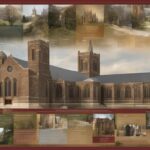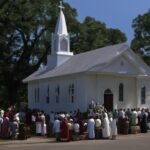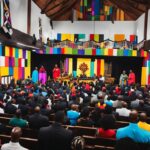The Church Mission is dedicated to advancing faith and community through its mission statement and church vision. With a strong commitment to making disciples of all nations, the Church Mission tirelessly works towards spreading the message of hope and love. Through various local outreach programs and partnerships, the Church Mission actively engages with the community to meet their needs and support them in times of difficulty. The Church Mission also extends its reach through international missions, establishing churches and training pastors in countries across the globe.
Key Takeaways:
- The Church Mission is focused on advancing faith and community through its mission statement and church vision.
- It actively engages in local outreach and partnerships to provide support and assistance to those in need.
- The Church Mission works towards establishing gospel-centered churches and training pastors internationally.
- Through its unwavering commitment to its mission, the Church Mission strives to make a positive difference in communities and lives.
- The Church Mission embraces the power of faith and outreach to transform lives and promote spiritual growth.
History and Origins of Church Mission
The Church Mission has a compelling history that stretches back to the time of Jesus Christ. Inspired by His teachings, the Church Mission has evolved and developed over the years, adapting to the changing needs of communities and cultures.
The origins of the Church Mission can be traced to the early Christian church depicted in the New Testament. It was born out of the command of Jesus to make disciples of all nations, spreading the message of faith and serving the community.
Throughout history, the Church Mission has played a pivotal role in advancing faith and community. From humble beginnings, it has grown into a global movement, with churches and missionaries located in various parts of the world. The Church Mission has relentlessly pursued its mission of bringing hope, love, and the teachings of Christ to individuals and societies.
As the Church Mission has developed, it has adapted its strategies and approaches to reach a diverse range of people. It has embraced new technologies and methods of communication to spread the message of faith more effectively. The Church Mission has also responded to the social and cultural challenges of different eras, supporting various initiatives that aim to improve the well-being of individuals and communities.
“We strive to honor our roots and the legacy of those who came before us, while also embracing innovation and change to fulfill our mission in the modern world,” says Reverend James Anderson, a prominent figure in the Church Mission.
Through perseverance and unwavering faith, the Church Mission has established a strong presence in countless communities, bringing people together in worship, service, and spiritual growth.
Key Milestones in the History of Church Mission
The history of the Church Mission is marked by significant milestones that have shaped its development and impact:
- The establishment of the first missions by early Christian leaders, such as the Apostle Paul’s missionary journeys
- The spread of Christianity through Roman Emperor Constantine’s conversion in the 4th century
- The Protestant Reformation in the 16th century, which led to the formation of numerous denominations and the expansion of mission efforts
- The global mission movement in the 19th and 20th centuries, with an increasing emphasis on reaching unreached people groups and supporting indigenous church growth
- The integration of mission work with social justice initiatives and humanitarian aid in the contemporary era
The Continual Development of Church Mission
The Church Mission continues to evolve and adapt to meet the changing needs of society. It remains committed to advancing faith and community through its expansive network of churches, missionaries, and community initiatives.
By embracing its historical foundations while embracing innovation, the Church Mission seeks to continue its transformative work in bringing hope, healing, and the love of Christ to individuals and communities around the world.
| Year | Key Event |
|---|---|
| 30 AD | The founding of the Church Mission with Jesus’ command to make disciples of all nations |
| 1st century AD | The early spread of the Church Mission through the ministry of the apostles |
| 4th century AD | The adoption of Christianity as the official religion of the Roman Empire |
| 16th century AD | The Protestant Reformation and the subsequent growth of mission efforts |
| 19th and 20th centuries AD | The expansion of global missions and the focus on reaching unreached people groups |
| 21st century AD | The integration of mission work with social justice initiatives and humanitarian aid |

Beliefs and Doctrines of Church Mission
The Church Mission is rooted in a set of beliefs and doctrines that underpin its faith and shape its mission to advance faith and community. These core principles serve as guiding lights for the Church Mission:
- The Trinity: The Church Mission believes in the One God who exists eternally in three persons: God the Father, God the Son (Jesus Christ), and God the Holy Spirit. This divine unity and diversity reflect the nature of God.
- Divinity and Humanity of Jesus Christ: The Church Mission affirms the belief that Jesus Christ is fully divine and fully human. This understanding acknowledges Christ’s role as the promised Messiah, who bridges the gap between humanity and God.
- Salvation Through Faith: Church Mission teaches that salvation is a gift of God’s grace and is received through faith in Jesus Christ. This belief emphasizes the importance of personal acceptance of Christ’s sacrifice for the forgiveness of sins.
- Authority of Scripture: The Church Mission recognizes the Bible as the inspired Word of God, holding authority in matters of faith, doctrine, and practice. The Scriptures guide and inform the Church Mission’s teachings and provide a foundation for spiritual growth.
In addition to these foundational beliefs, the Church Mission places strong emphasis on the power of prayer, the importance of spiritual growth, and the call to live out one’s faith in daily life. These principles encourage believers to seek a deepening relationship with God and demonstrate their love for others through compassionate service and transformative actions.

“Our beliefs guide us, shaping our understanding of God, salvation, and our purpose in the world. They inspire and empower us to live out our faith, bringing light and hope to those around us.”
Sacraments and Rituals in Church Mission
The Church Mission embraces the practice of various sacraments and rituals, which hold deep religious and spiritual significance. These sacraments and rituals serve as powerful expressions of faith and community within the Church Mission, fostering a sense of unity and reverence among its members.
Baptism:
One of the sacraments observed in the Church Mission is baptism. Baptism symbolizes the cleansing and rebirth of a believer, signifying their commitment to Christ and their entry into the Christian community. Through the act of immersion or pouring of water, individuals publicly declare their faith and dedication to living a Christ-centered life.
The Lord’s Supper:
The Church Mission also practices the sacrament of the Lord’s Supper, also known as communion. This sacred ritual commemorates the sacrificial death and resurrection of Jesus Christ. Through the sharing of bread and wine (or grape juice), believers remember and participate in the redemptive work of Christ, experiencing a deep spiritual connection with Him and fellow members of the Church Mission.
Rituals of Life:
In addition to sacraments, the Church Mission also conducts various rituals that mark significant moments in the lives of its members. Weddings, funerals, and the laying on of hands for healing and blessing are examples of these rituals. Weddings celebrate a sacred union between two individuals, while funerals provide an opportunity to honor and remember those who have passed away. The laying on of hands offers a prayerful act of seeking divine intervention for healing or invoking God’s favor and blessings.
These sacraments and rituals not only deepen individual faith but also strengthen the bond between believers within the Church Mission. They provide moments of reflection, celebration, and connection with the divine presence.
Key Takeaways:
- The Church Mission practices sacraments such as baptism and the Lord’s Supper.
- Baptism signifies the cleansing and rebirth of a believer, while the Lord’s Supper commemorates the death and resurrection of Jesus Christ.
- The Church Mission also performs rituals for weddings, funerals, and the laying on of hands.
- These sacraments and rituals serve as important expressions of faith and community within the Church Mission.
Leadership and Clergy in Church Mission
In the Church Mission, leadership plays a crucial role in guiding and overseeing the activities of the church. The clergy, including pastors, priests, and ministers, are at the forefront of leading worship services, providing spiritual guidance and counseling, and facilitating community outreach. They are dedicated servants who exemplify the values and teachings of the Church Mission.
Under the guidance of the clergy, the Church Mission operates with a system of church governance that ensures effective decision-making and sets the direction of the church. The clergy are entrusted with the responsibility of making important decisions that impact the faith community and its mission.
One of the primary roles of the clergy in the Church Mission is to lead worship services. They create a sacred and meaningful experience for the congregation, guiding them in prayer, sharing teachings from sacred texts, and leading them in song and praise. The clergy’s ability to inspire and connect with worshippers helps foster a deeper sense of faith and community.
Beyond worship services, the clergy also provide spiritual guidance and counseling to individuals and families who seek support during challenging times. They offer wisdom, guidance, and a compassionate ear to those in need, helping them navigate life’s struggles and find solace in their faith.
“The clergy are the shepherds of our faith community, guiding us on our spiritual journey and helping us discover the richness of our faith. They are our mentors, confidants, and role models, embodying the values and teachings of the Church Mission.”
Community outreach is an integral part of the Church Mission’s mission, and the clergy are at the forefront of facilitating these efforts. They actively engage with local communities, forging partnerships with community organizations, and organizing mission trips and volunteer opportunities. Through these initiatives, the clergy and the Church Mission work together to address social issues, promote justice, and meet the practical needs of individuals and families.
The leadership in the Church Mission also plays a vital role in nurturing and supporting the spiritual growth of its members. They provide opportunities for discipleship, teaching, and fellowship, helping believers deepen their faith and develop a personal relationship with God.
Guiding Principles of Church Leadership
The Church Mission’s leadership operates based on key guiding principles that shape their approach to ministry and service. These principles include:
- Servant Leadership: The clergy model servant leadership, understanding that their role is to serve the needs of the faith community and empower others to fulfill their calling.
- Collaboration: The clergy work alongside other leaders and members of the church, fostering collaborative decision-making and ensuring diverse voices are heard.
- Accountability: The clergy are accountable to God, the congregation, and the broader church body, ensuring transparency and integrity in their actions and decisions.
- Spiritual Growth: The clergy are committed to their own ongoing spiritual growth and encourage others to do the same, understanding that leadership starts with personal transformation.
The leadership and clergy in the Church Mission are an essential part of advancing the mission and values of the church. Their dedication, guidance, and service are instrumental in nurturing faith, fostering community, and making a positive difference in the lives of individuals and the broader society.

Worship Practices in Church Mission
Worship is at the heart of the Church Mission, serving as a powerful expression of faith and a means of connecting believers with God. The worship services in the Church Mission are vibrant and engaging, encompassing a variety of practices and expressions that inspire and uplift the congregation.
Singing Hymns and Spiritual Songs: One of the central components of worship services in the Church Mission is the singing of hymns and spiritual songs. These musical expressions of praise and worship create an atmosphere of reverence and joy, allowing believers to unite their voices in worshiping God and declaring His greatness.
Prayer: Prayer is an integral part of worship in the Church Mission. Believers come together to offer their praises, thanksgiving, and supplications to God. Through prayer, they seek guidance, find solace, and express their deepest desires and emotions.
Reading and Teaching from Sacred Texts: The Church Mission places great importance on studying and understanding the sacred texts, primarily the Bible. During worship services, there is a dedicated time for reading and teaching from the Scriptures. Pastors and leaders expound on the Word of God, providing insights and application to guide the congregation in their faith journeys.
Corporate Worship through Praise and Thanksgiving: The Church Mission values the collective worship experience and emphasizes the power of corporate praise and thanksgiving. Believers join together, lifting their voices and hearts in unity, expressing gratitude, and exalting God’s name. This collective worship fosters a sense of community, encouraging believers to support and uplift one another.
The worship practices within the Church Mission may vary across different denominations and sects. These variations often reflect the traditions and cultural influences unique to each group, adding richness and diversity to the worship experience.

Sacred Texts in Church Mission
The Church Mission holds the Bible as its primary sacred text and source of authority for matters of faith and practice. The Bible, comprising the Old and New Testaments, is considered to be inspired by God, providing guidance for the beliefs and teachings of the Church Mission. Through the study, interpretation, and application of Scripture, the Church Mission seeks to deepen understanding and faith.
The Church Mission places great importance on the authority of the Bible, recognizing it as the ultimate source of truth and guidance. The sacred texts within the Bible contain the teachings, narratives, prophecies, and commandments that shape the Church Mission’s beliefs and practices. It is through the study of Scripture that believers gain insight into God’s will and divine plan.
“The word of God is living and active, sharper than any two-edged sword, piercing to the division of soul and of spirit, of joints and of marrow, and discerning the thoughts and intentions of the heart.” – Hebrews 4:12
While the Bible serves as the primary sacred text, it is worth noting that various denominations and sects within the Church Mission may also have additional sacred texts or interpretations that they consider significant. These texts can provide further insight into specific traditions, rituals, and theological understandings within different branches of the Church Mission.
Biblical Authority in the Church Mission
The Church Mission upholds the authority of Scripture as foundational to its beliefs and teachings. The Bible is regarded as God’s revelation to humanity, expressing the divine will and providing wisdom for discipleship and righteous living. By recognizing the biblical authority, the Church Mission seeks to align its practices, ethics, and doctrines with the teachings of Scripture.
Through the careful examination and interpretation of biblical texts, the Church Mission’s leaders and scholars derive principles and guidelines for the community. These interpretations and teachings aim to promote spiritual growth, discipleship, and a faithful adherence to the Gospel message.
Scripture Teachings in the Church Mission
The Church Mission views Scripture as a treasure trove of teachings and life lessons. It emphasizes the importance of biblical study and application to nourish personal faith and guide daily lives. Through the teachings within sacred texts, believers gain insights into God’s character, His redemptive work, and the values that should shape their behavior.
- The Teachings of Jesus: The Church Mission places a special emphasis on the teachings of Jesus Christ as recorded in the Gospels. These teachings, including the Sermon on the Mount and the parables, provide guidance on moral living, love for others, forgiveness, and the nature of God’s Kingdom.
- Doctrinal Teachings: The Church Mission derives its doctrinal beliefs from the teachings found throughout the Bible. Key doctrines, such as the Trinity, salvation through faith, and the divinity and humanity of Jesus, inform the Church Mission’s understanding of God, humanity, and the plan of redemption.
- Moral and Ethical Guidelines: Scripture provides ethical instructions that shape the Church Mission’s approach to various aspects of life. The Ten Commandments, for example, guide believers in matters of personal integrity, relationships, and social justice.
By studying and meditating on the teachings of Scripture, the Church Mission seeks to cultivate a holistic understanding of God’s will, foster personal transformation, and equip believers to engage actively in their communities.

| Key Points | Key Verses |
|---|---|
| The Church Mission considers the Bible as its primary sacred text. | 2 Timothy 3:16-17 – “All Scripture is breathed out by God and profitable for teaching, for reproof, for correction, and for training in righteousness, that the man of God may be complete, equipped for every good work.” |
| The authority of Scripture guides the Church Mission’s beliefs and practices. | Psalm 119:105 – “Your word is a lamp to my feet and a light to my path.” |
| The Church Mission emphasizes the study and application of Scripture for spiritual growth and understanding. | Joshua 1:8 – “This Book of the Law shall not depart from your mouth, but you shall meditate on it day and night, so that you may be careful to do according to all that is written in it. For then you will make your way prosperous, and then you will have good success.” |
Denominations and Sects in Church Mission
The Church Mission is a diverse and vibrant community that encompasses various denominations and sects, each with its own unique beliefs, practices, and organizational structures. While they may have differences, these denominations and sects share a common commitment to the Church Mission’s mission of advancing faith and community.
Examples of denominations within the Church Mission include:
- Baptist
- Presbyterian
- Methodist
- Lutheran
- Pentecostal
These denominations, among others, play a crucial role in shaping the religious landscape within the Church Mission. Each denomination brings its own theological emphases, worship styles, and governance practices to the table, enriching the overall spiritual experience and fostering a sense of unity amidst diversity.
By embracing the various denominations and sects within its fold, the Church Mission demonstrates its commitment to embracing a wide range of perspectives and approaches to faith. This inclusivity allows individuals to find a spiritual home that resonates with their beliefs and engages them in meaningful worship, service, and personal growth.
Furthermore, the denominations and sects within the Church Mission provide opportunities for collaboration and mutual support. Through interdenominational gatherings, joint initiatives, and shared resources, these different religious divisions foster a sense of working together towards common goals, such as community outreach, social justice, and positive transformation.
As the Church Mission continues to evolve and adapt to meet the needs of contemporary society, the presence of diverse denominations and sects remains a testament to its ability to embrace religious diversity while remaining rooted in its mission of advancing faith and community.
Community and Outreach in Church Mission
Community and outreach are integral aspects of the Church Mission’s mission. The Church Mission actively engages with local communities through various initiatives such as mission trips, volunteer opportunities, and partnerships with local organizations. These outreach efforts aim to address the needs of individuals and families, promote social justice and compassion, and positively impact the community. The Church Mission seeks to be a catalyst for positive change and transformation, bringing hope, healing, and spiritual growth to those it serves.
Mission Trips: Making a Global Impact
As part of its commitment to community outreach, the Church Mission organizes mission trips to different parts of the world. These trips provide volunteers with the opportunity to serve and make a tangible difference in the lives of others. Mission trips often involve activities such as building schools, houses, or churches, providing medical assistance, and offering educational programs. Through these experiences, participants not only contribute to the betterment of communities but also gain a broadened perspective on the world and their own faith.
Volunteer Opportunities: Making a Local Impact
The Church Mission recognizes the importance of serving the local community. It offers various volunteer opportunities for church members and individuals interested in making a positive impact close to home. These opportunities range from working in community centers, homeless shelters, and food banks to mentoring programs, tutoring services, and youth outreach initiatives. By getting involved through volunteering, individuals can actively contribute to addressing the needs of their own communities, fostering a sense of unity and compassion.
Partnerships for Lasting Impact
The Church Mission values collaboration and partnerships with local organizations to maximize the impact of its outreach efforts. By joining forces with like-minded community groups, the Church Mission builds strong alliances and amplifies its outreach capabilities. These partnerships allow for shared resources, collective expertise, and a wider network to address community issues more effectively. Together with other organizations, the Church Mission can create lasting change and enhance the well-being of individuals and families.
Architectural and Artistic Features of Church Mission
The Church Mission is not only a place of worship but also a visual representation of its beliefs, history, and cultural influences. The architecture of churches within the Church Mission varies, with each style evoking a different atmosphere of reverence and awe. From the grandeur of Gothic cathedrals to the simplicity of contemporary designs, every architectural choice is intentional and serves a purpose.
Artistic elements play a significant role in enhancing the sacred atmosphere of Church Mission spaces. Stained glass windows, bring vibrant colors and intricate designs to life. These windows often depict biblical scenes, saints, and religious symbols, conveying spiritual stories and teachings to worshippers. The play of light through stained glass creates a transcendent experience, illuminating the interior and inspiring awe and contemplation.
Statues and sculptures are also common in Church Mission spaces. They represent biblical figures, saints, and important historical figures, serving as objects of veneration and inspiration. These sculptures depict the virtues and stories of those they represent, reminding worshippers of their spiritual journey and the examples set by these individuals.
Paintings and murals adorn the walls of many Church Mission buildings. These works of art often depict scenes from the Bible or religious narratives, visually illustrating key teachings and events. They bring to life stories of faith, serving as visual representations of the sacred texts that form the foundation of the Church Mission’s beliefs. These artistic expressions engage the senses, enhancing the worship experience and facilitating a connection with the divine.
The architectural and artistic features of the Church Mission are not merely decorative but also carry deep symbolic meaning. They serve as visual reminders of the Church Mission’s core beliefs and values, inviting worshippers to engage with their faith on a spiritual and intellectual level. The interplay between architecture, art, and sacred symbolism creates a sacred space where worshippers can connect with the divine, find solace, and experience the transformative power of faith.
Conclusion
The Church Mission is a beacon of faith and community, steadfast in its commitment to serving others and advancing its mission. With a rich history and a strong belief system, the Church Mission has guided countless individuals towards a deeper spiritual connection and a stronger sense of community. Its impact extends far beyond the walls of its buildings, reaching into the hearts and lives of those it serves.
Through its unwavering faith and dedication to outreach, the Church Mission has the power to transform lives. By embracing its mission, individuals are inspired to serve, uplift, and support one another, fostering a sense of unity and compassion within the community. Whether through local initiatives or international missions, the Church Mission actively seeks to make a positive difference in the lives of those in need.
As the Church Mission navigates contemporary issues and challenges, it remains resilient and adaptive. It recognizes the importance of staying relevant and impactful in its mission, continuously innovating to meet the evolving needs of communities. Through worship practices, sacraments, and leadership, the Church Mission provides a strong foundation for spiritual growth, nurturing believers in their faith journey.
The Church Mission’s architectural and artistic features reflect its deep reverence for the sacred. From elaborate stained glass windows to intricately carved structures, these elements create a space of worship that inspires awe and devotion. Such symbolic representations of faith serve as reminders of the Church Mission’s enduring commitment to its beliefs and the timeless truths it upholds.
FAQ
What is the mission statement of the Church Mission?
The Church Mission is focused on advancing faith and community through its mission statement and church vision.
What is the history and origin of the Church Mission?
The Church Mission has a rich history and origins that date back to the time of Jesus Christ.
What are the beliefs and doctrines of the Church Mission?
The Church Mission is guided by a set of beliefs and doctrines that form the foundation of its faith.
What sacraments and rituals are practiced in the Church Mission?
The Church Mission practices various sacraments and rituals that hold significant religious and spiritual meaning.
What is the leadership structure of the Church Mission?
The Church Mission operates under a leadership structure that includes clergy and other leaders who guide and oversee its activities.
What are the worship practices in the Church Mission?
Worship is a central aspect of the Church Mission, and it encompasses a range of practices and expressions.
What are the sacred texts of the Church Mission?
The Church Mission holds the Bible as its primary sacred text and source of authority for matters of faith and practice.
What denominations and sects are part of the Church Mission?
The Church Mission encompasses a diverse range of denominations and sects that have distinctive beliefs, practices, and organizational structures.
How does the Church Mission engage in community outreach?
Community and outreach are integral aspects of the Church Mission’s mission, and it actively engages with local communities through various initiatives.
What are the architectural and artistic features of the Church Mission?
The Church Mission often incorporates architectural and artistic features that reflect its beliefs, history, and cultural influences.
What is the role of the Church Mission in advancing faith and community?
The Church Mission plays a vital role in advancing faith and community through its mission and activities.
















